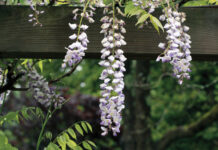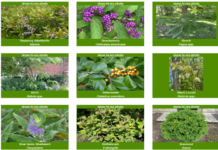
The South Slough National Estuarine and Research Reserve in Oregon is asking coastal residents to survey their properties and remove pampas grass, following an extensive initiative that recently removed more than 5,000 of the plants from the Reserve.
Pampas grass is the common name for two invasive plant species of increasing concern along the west coast in Washington, California and Oregon: Cortaderia jubata and C. selloana. The two species look similar, with tall stalks that can reach 6′ – 23′ in height, and large flower plumes that spread out at the end of the stalks. The plumes vary in color from deep purple, to pink or light brown.
Both species of pampas grass are often used in landscaping, which contributes to its spread and effects on fragile coastal ecosystems. The plants spread by seeds, which are very light and can be dispersed in the wind and by human activity. Coastal residents can reduce the spread of pampas grass and its impact by removing the plants from their properties, says the South Slough Reserve. The best time to remove it is during the spring, when soil is moist and it is easier to pull out the plant’s roots. Additional chemical control may be necessary as a last resort.
Landscapers in other areas may want to check with their local extension office before specifying pampas grass in a landscape design. While still widely promoted and used as a landscape plant for its dramatic size and feathery plumes, it is just starting to gain a reputation as a coastal invasive in other states, such as NJ. It’s listed as an invasive in Texas and banned in Hawaii and New Zealand, according to an article by HGTV.com.
Coastal ecosystems, as well as residential and commercial properties, are impacted by the presence of pampas grass. The plants crowd out native plants and compete with seedling trees in forested areas, hindering their ability to grow. The long stalks and flowers make it a fire hazard for forested areas and homes. It can also block vehicle access to roads that are crucial during emergencies, like wildfires. Finally, pampas grass can attract and harbor rats, according to South Slough Reserve.

This January, the Reserve coordinated with Coos Forest Protective Association to remove 140 cubic yards of pampas grass from the Reserve—over 5,000 plants. This removal targeted C. jubata, a species that can easily spread when its seeds are dispersed for miles by the wind. The pampas grass was growing in three patches around the Reserve. To remove the plants, workers used chainsaws to cut the leaves at their base and then dug the roots out with shovels.
“It took us a little over ten days, about 650 person hours, to completely eliminate pampas grass within the Reserve,” said Dr. Alice Yeates, Stewardship Coordinator for South Slough Reserve. “However, there is always a chance it could reestablish.”
PHOTOS: Top center: AdobeStock; Chart and bottom photo from Washington State Department of Agriculture.











![[VIDEO] Dickies®: Discover Workwear That’s Anything But Uniform](https://turfmagazine.com/wp-content/uploads/2023/06/1647663814-4b1a2a7742790a9b1e97a3b963477850192e1d6a9dfba9b07214a77bae25d6e3-d-218x150.jpg)





























![[VIDEO] Dickies®: Discover Workwear That’s Anything But Uniform](https://turfmagazine.com/wp-content/uploads/2023/06/1647663814-4b1a2a7742790a9b1e97a3b963477850192e1d6a9dfba9b07214a77bae25d6e3-d-324x160.jpg)